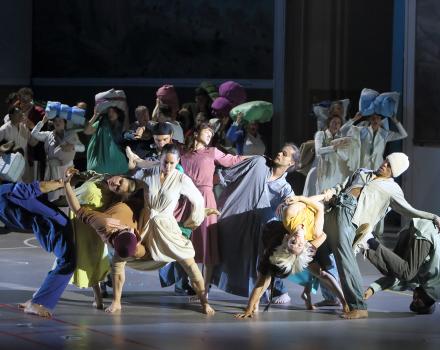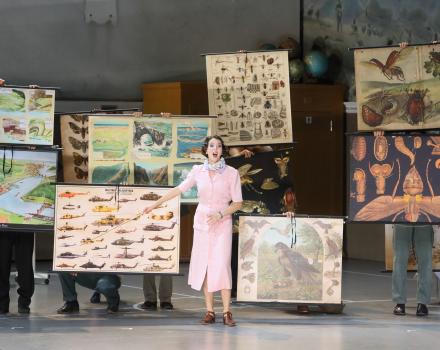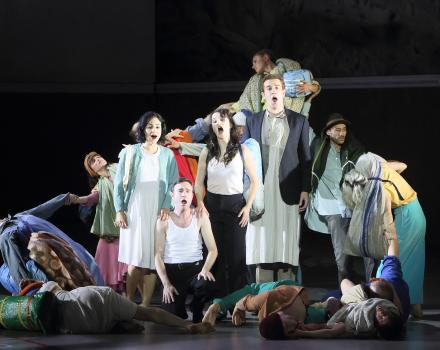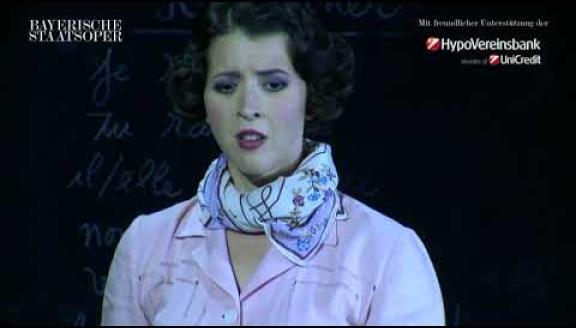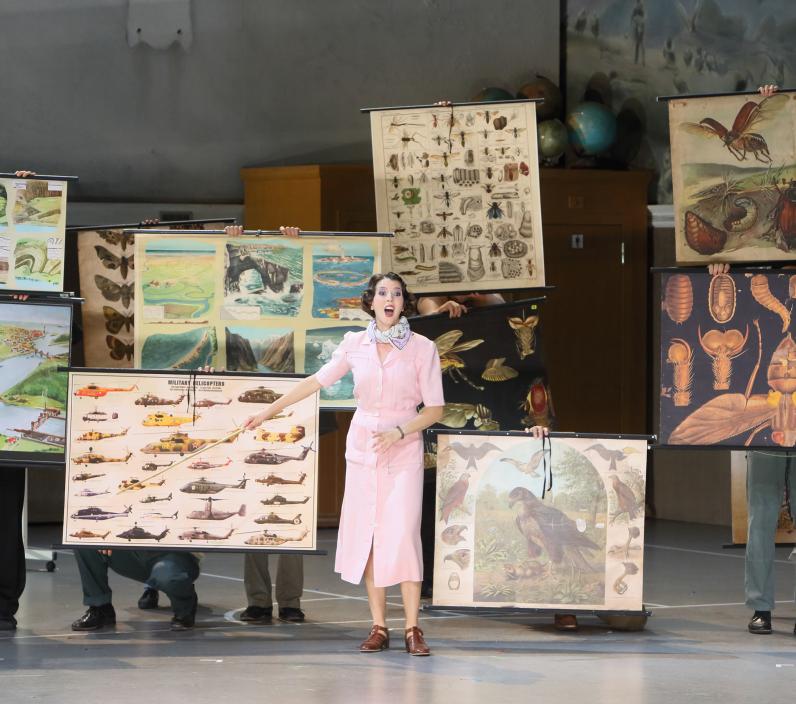

Les Indes galantes

While the young people of Europe forsake Love to follow Bellone at war, Cupid sets out to shoot his arrows into the rest of the world.
A masterpiece of the Enlightenment, Les Indes galantes is sparkling entertainment. Yet Rameau’s first opera‑ballet also bears witness to the Europeans’ ambiguous view of ‘savage’ cultures. The Belgian choreographer-director Sidi Larbi Cherkaoui adapts Les Indes Galantes to a contemporary setting, where globalisation has transformed the notions of exoticism.
Cast
Hébé | Lisette Oropesa |
|---|---|
Bellone | Goran Jurić |
L'Amour | Ana Quintans |
Osman | Tareq Nazmi |
Emilie | Elsa Benoit |
Valère | Cyril Auvity |
Huascar | François Lis |
Phani | Anna Prohaska |
Don Carlos | Mathias Vidal |
Tacmas | Cyril Auvity |
Ali | Tareq Nazmi |
Zaire | Ana Quintans |
Fatime | Anna Prohaska |
Damon | Mathias Vidal |
Don Alvaro | François Lis |
Zima | Lisette Oropesa |
Adario | John Moore |
Dancers | Tänzer der Compagnie Eastman, Antwerpen |
Chorus | Balthasar-Neumann-Chor, Freiburg |
Orchestra | Münchner Festspielorchester |
| ... | |
Music | Jean-Philippe Rameau |
|---|---|
Conductor | Ivor Bolton |
Stage director & Choreographer | Sidi Larbi Cherkaoui |
Set designer | Anna Viebrock |
Costumes designer | Greta Goiris |
Lighting | Michael Bauer |
Dramaturgy, adaptation | Antonio Cuenca, Miron Hakenbeck |
Chorus Master | Detlef Bratschke |
| ... | |
Video
The story
Prologue
Hébé gathers the youth together in order to pass on her knowledge about love and human nature. She is interrupted by Bellona, who wins over countless young people with her ideals of war. While the latter head into battle, Hébé remains behind, bewildered. Then Love comes to her rescue. Encouraged, Hébé goes out in search for ways to realise her ideas and virtues.
Act I – The generous Turk
Emilie is, for Osman, an object of worship. He urges her relentlessly to submit to his amorous advances. She however remains true to her beloved Valère, whom she lost when they were separated from each other by a catastrophe. Emilie fears Valère may no longer be alive. Her fear overwhelms her, and is echoed suddenly by a breaking storm. After the storm has abated, Emilie discovers Valère among a group of new arrivals. Her joy at seeing him again is interrupted by Osman, who, contrary to all expectation, allows Emilie to leave with Valère and wishes the couple a happy future.
Act II – The Incas of Peru
The Priest Huascar loves Phani, a believer in his congregation. But she has chosen a stranger called Carlos, who loves her too and encourages her to give up her faith. Huascar tries to break up this love and to win Phani for himself by pretending to be the mouthpiece of God's will and awakening Phani's guilt. In order to increase his influence over her, he goes as far as to stage supernatural phenomena in the religious ceremony. Carlos discovers the means by which these wonders are evoked and reveals the deceitful schemes to Phani. Phani and Carlos flee. Left behind alone, Huascar begs to be struck down by God's wrath.
Act III – The flowers, a Persian festival
Tacmas and Fatime disguise themselves for love: dressed up as the opposite sex, each of them hopes to draw closer to their beloved ones: Tacmas loves Zaïre, the slave of his friend Ali. Ali in turn desires Fatime, who is owned by Tacmas. After many entanglements due to mistaken identities, two couples celebrate their love and the start of their new lives together.
Act IV – The Savages
The military commander, Adario, has succeeded in ensuring peace for his nation. Despite this success, he is deeply worried that his adored Zima could be in love with someone else. He hides so that he can eavesdrop on two strangers who are also wooing Zima: Damon and Alvar. Damon is as frivolous and free as Alvar is loyal and jealous. However, Zima prefers Adario, since he combines the qualities of the both without showing any weaknesses. After he reveals himself, Adario and Zima affirm their love. With this assurance, they celebrate their bond as well as the newly won peace.
Insights
The stranger in us
In Les Indes galantes, a French baroque opera-ballet composed in 1735, Jean-Philippe Rameau tells stories about love, jealousy and redemption in four different episodes and as many different cultural contexts. Where the composer was seduced by the exoticism of foreign lands, peopling his opera with Turks, Peruvians, Persians and Native Americans, the Belgian director and choreographer Sidi Larbi Cherkaoui highlights the familiar in the unknown.
The relationship to foreign cultures in the work has a sense of naivety. I love to keep that naivety because there’s something beautiful about it, but then reverse it and compare those cultures much more with what we know.
Together with a large ensemble of singers and the dancers from his Compagnie Eastman from Antwerp, Cherkaoui sets the action in a more or less contemporary world, approaching it with a typically baroque profusion.
He connects the four distinct episodes set in far-away places into one overarching story. The soloists sing different roles which nonetheless melt into a single character. ‘There are less characters, but they live more complex love stories’, Cherkaoui explains. ‘Actually, because these love stories are more complex, they are more real and they connect more with what love is today.’
The soprano Lisette Oropesa, for instance, embodies both Hébé and Zima. In the prologue, the goddess of youth Hébé is shown as a schoolteacher. ‘She is always trying to bring forth the ideas of nature, peace, love and harmony, because in the world that we’ve established in this opera, there’s a lot of tension. People are always looking for love among cultural tension,’ says Oropesa.
As movement plays a central role in this opera-ballet, Cherkaoui is particularly attentive to questions of rhythm. Set changes occur with the help of dance as dances move the stage equipment towards the end of each act. The following act’s scenery is set up in smooth transitions before the end of the previous one. Not only does this disrupt the idea of a single space, it also underlines the continuity of the subject matter between different acts. Even as we are taken from one continent to another, we stay true to our subject matter: love.
In Act II, for instance, Cherkaoui cheekily transforms the Inca priest Huascar into a Catholic one. As the priest marries a ballet of couples, we see him refuse his blessing to a gay couple. Here the sharp religious criticism characteristic of Cherkaoui's work shines through.
When you compare yourself to other cultures, you realise that you are exactly the same. You have the same framework. Whatever will happen to them could happen to you.
With its loaded title ‘The Savages’, Act IV presents migrants engaged in menial jobs like cleaning. Here Cherkaoui choreographs the extraordinary solo act of a cleaner-dancer around his broom, there a human chain moving as if in a cascade of dominos.
When Lisette Oropesa returns in the role of Zima, she still appears as a teacher. ‘By this time a lot of things have happened to our group of refugees,’ Oropesa explains. ‘Several different races of people are clashing and the world has basically been destroyed. Zima is still trying to teach these small children how to continue on in this world full of violence.’
The overall message conveyed is not a reductive or pessimistic worldview as much as it presents a canvas of humanity. The dances are additional characters in this vision. ‘All of these singers,’ says Cherkaoui, ‘are facettes of our own humanity. And I think the dancers are as well. So even if they don’t say anything, they are very important, because sometimes in your life it’s the people who say the least, who do the most.’
Through the language of music and the language of dance, Cherkaoui’s staging of Les Indes galantes tells a story of colliding cultures and ultimately a story of us.
Gallery

